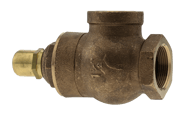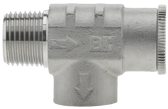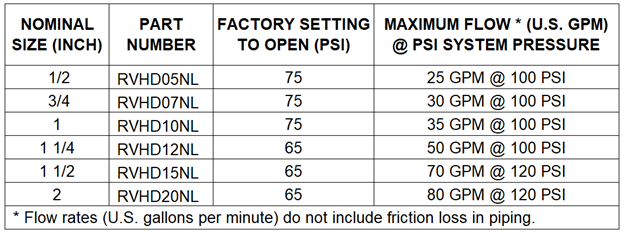Relief valves are designed to create the proper pressure within your tank, ensuring there isn't a build-up of too much pressure. When it comes to adjusting relief valves, many cautions and warnings need to be taken into consideration. Certain relief valves allow adjustment, but extreme caution needs to be taken as improper confirmation on how the adjustment went could cause significant damage.
In this blog, we will go over (including the use of a chart) how to select the proper size relief valve for your application, and tips on safely and properly adjusting a relief valve.
Relief Valves
Every installation where the pump has the possibility of producing more pressure than the pressure tank's capability must have a relief valve installed. Without a relief valve, an accidental sticking of the pressure switch contacts could cause the pump to continue running which could result in the pressure tank bursting.
For more information on why you should install a relief valve, check out our blog: 3 Reasons to Install a Relief Valve.
It is important to note that not all relief valves can be adjusted. Heavy duty relief valves have the capability to be adjusted, but it is the installer's responsibility to select and confirm that the relief valve they are using is adjustable. More economic relief valves that have a factory set of either 75 PSI or 100 PSI are non-adjustable.
the relief valve they are using is adjustable. More economic relief valves that have a factory set of either 75 PSI or 100 PSI are non-adjustable.
 The picture on the right shows an example of an adjustable relief valve and the photo on the left shows an example of a non-adjustable relief valve.
The picture on the right shows an example of an adjustable relief valve and the photo on the left shows an example of a non-adjustable relief valve.
The main responsibility of the system designer or installer is to accurately select a pressure relief valve that has good flow characteristics that can maintain a maximum pressure considerably lower than the system's designed pressure. Typically, this can be determined by knowing the maximum pressure rating of the pressure tank. To find this out, you may need to contact the tank manufacturer if it is not clearly labelled on the tank itself.
Below is a flow guide that you can follow to help you select the proper size relief valve for your application. If you are getting close to the maximum gallons per minute (GPM) of your system, it is recommended that you go up a minimum of one size ensuring that there is adequate flow to compensate for the friction loss that can happen in the piping.

CAUTIONS
As already stated multiple times: when working with and adjusting relief valves, you need to take extreme caution. Field adjustment is NOT recommended on pressure relief valves. If the factory setting on the relief valve is changed in the field, the installer must test the system to ensure the setting that was changed will still allow good pressure relief for the size of the entire system.
The submersible pump's total flow capacity cannot exceed the pressure tank's rated capacity if the pressure switch does not succeed in properly cutting off the pump.
Heavy Duty Relief Valve Adjustment Instructions
- All the adjusting screws you will need are concealed with acorn nuts to prevent tampering. When the pump or compressor is running, you can remove any tags and the acorn nuts.
- By turning the adjustment screw counterclockwise until the pressure gauge is below the desired setting, you will loosen the jam nut and reduce the spring tension.
- You will then need to retighten the adjustment screw tension by turning the adjustment screw clockwise to the desired setting.
- Lastly, you need to test the setting. The gauge needle will drop abruptly at the relief setting.
Testing the Adjustment
Failing to confirm that the adjustment is executed correctly and safely could result in serious damage and injury. In order to properly verify, you will need to safely test by bypassing the pressure switch. You will need to watch the calibrated pressure gauge that's in the system. The tester must be positioned near the manual switch at the pump to quickly shut it off if the system pressure creeps closer to the maximum rating of the pressure tank. If the output of the pump exceeds the capacity of the re-set pressure relief valve, you will need to select a higher flow rate PRV.
Note: Any system must be capable of producing a higher pressure than what you desire in order to receive an accurate setting. Tightening the adjusting screw without a relief drop on the pressure gauge is not recommended.
In Summary:
Relief valves add a certain peace of mind to your system. It is key to ensure that if an adjustment is needed, every step is taken with the utmost safety, and that proper testing is performed to ensure the adjustment was done correctly. Taking your time, and being aware of the cautions, will allow you to properly perform the adjustment.
Have further questions about this subject?

Head over to Boshart's Knowledge Base: technical product information, guidelines, and more.


![[Video] 3 Reasons to Install a Relief Valve](https://blog.boshart.com/hubfs/45.jpg)
.png)

SHARE